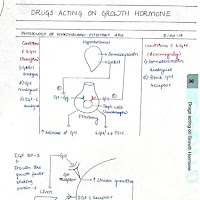Drugs Acting on Growth Hormone (GH) Notes: Downloadable PDF
Download comprehensive notes on drugs acting on growth hormone (GH) in PDF format. These notes cover medications used to treat conditions related to both GH deficiency and GH excess. Learn about different drug classes, including GH analogs (somatropin), IGF-1 analogs (mecasermin), somatostatin analogs (octreotide, lanreotide), and GH receptor antagonists (pegvisomant). Understand their mechanisms of action, clinical uses, benefits, and potential side effects. Ideal for students, researchers, and healthcare professionals. Download now for convenient offline access.
Keywords: Growth Hormone, GH, Drugs, Medications, PDF, Download, Notes, Somatropin, Mecasermin, Octreotide, Lanreotide, Pegvisomant, Pharmacology, Acromegaly, Gigantism, GH Deficiency, Growth Hormone Receptor, IGF-1, Somatostatin, Mechanism of Action, Clinical Uses, Side Effects, Growth Failure.
Drugs Acting on Growth Hormone (GH): Mechanisms and Therapies
Growth hormone (GH), also known as somatotropin, is a peptide hormone secreted by the anterior pituitary gland. It plays a crucial role in growth, metabolism, and body composition. Medications that act on the GH axis are used to treat conditions of GH deficiency or GH excess. This document provides an overview of these drugs.
Growth Hormone Physiology (Brief Overview)
- Secretion: GH secretion is pulsatile (occurs in bursts) and is regulated by the hypothalamus. Growth hormone-releasing hormone (GHRH) stimulates GH release, while somatostatin inhibits it.
- Actions: GH has direct and indirect effects:
- Direct Effects: GH binds to GH receptors on various tissues, including liver, muscle, and adipose tissue, influencing metabolism.
- Indirect Effects: GH stimulates the liver to produce insulin-like growth factor 1 (IGF-1), which mediates many of the growth-promoting effects of GH.
- Effects:
- Stimulates linear growth in children (through IGF-1)
- Increases protein synthesis
- Increases fat breakdown (lipolysis)
- Increases blood glucose levels (anti-insulin effect)
Drugs Used in Growth Hormone Deficiency
- Somatropin:
- Mechanism of Action: Somatropin is recombinant human growth hormone (rhGH). It is identical to the natural human GH and acts by binding to GH receptors, stimulating growth and metabolic effects.
- Clinical Uses:
- Growth hormone deficiency in children (leading to growth failure)
- Growth hormone deficiency in adults (can lead to decreased muscle mass, increased body fat, and reduced quality of life)
- Turner syndrome
- Prader-Willi syndrome
- Chronic kidney disease (in children)
- Idiopathic short stature (in some cases)
- Side Effects:
- Injection site reactions
- Edema (fluid retention)
- Arthralgia (joint pain)
- Myalgia (muscle pain)
- Carpal tunnel syndrome
- Increased intracranial pressure (rare)
- Glucose intolerance/diabetes (rare)
- Administration: Subcutaneous injection.
- Mecasermin:
- Mechanism of Action: Mecasermin is recombinant human insulin-like growth factor 1 (rhIGF-1). It is used in patients with severe IGF-1 deficiency that is not responsive to GH treatment (e.g., due to GH receptor defects or neutralizing antibodies to GH).
- Clinical Uses:
- Severe primary IGF-1 deficiency
- Side Effects:
- Hypoglycemia (low blood sugar) - *must be administered with food*
- Intracranial hypertension
- Tonsillar/adenoidal hypertrophy
- Administration: Subcutaneous injection.
Drugs Used in Growth Hormone Excess
GH excess is most commonly caused by a GH-secreting pituitary adenoma. This leads to gigantism in children (before the closure of growth plates) and acromegaly in adults.
- Somatostatin Analogs:
- Examples: Octreotide, Lanreotide, Pasireotide.
- Mechanism of Action: These drugs are synthetic analogs of somatostatin, a natural hormone that inhibits GH release. They bind to somatostatin receptors in the pituitary gland, suppressing GH secretion.
- Clinical Uses:
- Acromegaly
- Gigantism
- Other neuroendocrine tumors that over express somatostatin receptor.
- Side Effects:
- Gastrointestinal disturbances (nausea, diarrhea, abdominal pain)
- Gallstones
- Glucose intolerance/diabetes
- Bradycardia
- Administration: Octreotide can be given by subcutaneous injection (multiple times per day) or as a long-acting intramuscular injection (monthly). Lanreotide is available as a long-acting subcutaneous injection (every 4 weeks).
- Pegvisomant:
- Mechanism of Action: Pegvisomant is a GH receptor antagonist. It is a genetically engineered analog of GH that binds to the GH receptor but does not activate it. This blocks the action of endogenous GH, reducing IGF-1 levels.
- Clinical Uses:
- Acromegaly (when surgery or somatostatin analogs are not effective or not tolerated)
- Side Effects:
- Injection site reactions
- Elevated liver enzymes
- Lipohypertrophy (increased fat deposition at injection sites)
- Administration: Subcutaneous injection (daily).
- Dopamine Agonist
- Bromocriptine and cabergoline are effective in acromegaly.
In addition to medications, surgery (transsphenoidal surgery to remove the pituitary adenoma) and radiation therapy are also treatment options for acromegaly and gigantism.
Info!
If you are the copyright owner of this document and want to report it, please visit the copyright infringement notice page to submit a report.

